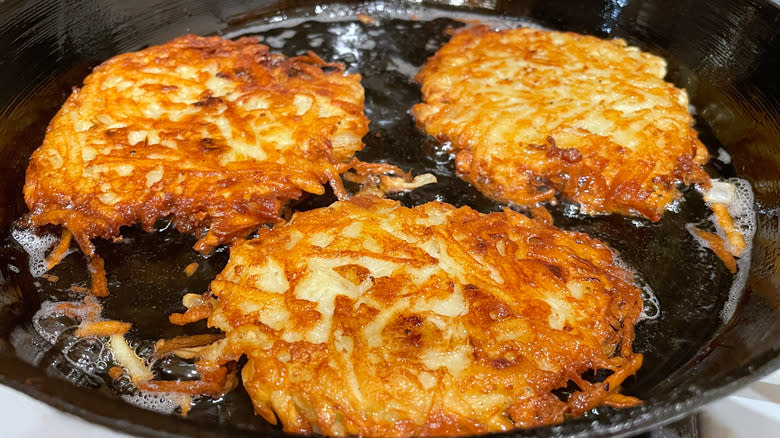The Timing Tip For The Crispiest Hash Browns In Your Breakfast Casserole

When it comes to breakfast sides, hash browns are always a good pick. With a crispy exterior and a soft, starchy, and salty interior, they're ideal for eating on their own or dipping in ketchup and other sauces. You can also turn this tasty side into a breakfast casserole, getting all your favorite morning fixings in one flavorful mashup.
The only difficulty with hash brown breakfast casseroles is that, rather than having delicious, golden, perfectly crispy hash browns, you can wind up with mushy ones instead. This might happen if you add the potatoes in raw, and then top them with liquid ingredients; they'll still cook, but they won't have quite as crispy of an exterior as they usually would. Luckily, there's a trick to get around that. All you have to do is pre-cook your hash browns before piling them into your casserole. This helps ensure you get that salty crunch to them and don't wind up with soggy potatoes floating around in your breakfast dish.
Read more: 11 Things You Didn't Know You Should Be Doing With Bacon
How To Get Perfect Hash Browns In Your Breakfast Casserole

When adding hash browns to your breakfast casserole, the first thing to think about is what style of hash browns you'll use. You can go for classic grated hash browns, or you can try home fries, tater tots, diced potatoes, or any other style of breakfast potatoes you love. You could also go for hash browns that come with shredded onion or other vegetables mixed in to add to the flavor of your breakfast bake. It's up to you to choose which you like, but note that you'll get different textures. If you go with breakfast potatoes, for instance, you'll have larger chunks of the tubers in your meal.
Whichever style you choose, to make sure you get crispy potatoes, the next step is to cook them. There are a few ways that you can go about this process. Firstly, you can cook them in a skillet until they're browned. Alternatively, you can bake them in the oven until they're just starting to turn golden and soften in the middle. This second method works well because you don't have to worry about dirtying extra dishes and can cook the hash browns directly in your casserole dish.
Other Tips To Avoid A Soggy Hash Brown Casserole

While pre-baking your hash browns can certainly help ensure you don't get a soggy breakfast bake, that's not the only trick to have up your sleeve. For one thing, remember that you can use either freshly homemade hash browns or your favorite brand of frozen hash browns for this recipe. If you go with frozen, while you don't necessarily have to thaw them, doing so can avoid introducing extra moisture to your dish and lead to a watery breakfast bake. If you do thaw them, you can also pat them dry with a towel to help pull out any excess moisture and ensure you get a crisp texture.
Besides the hash browns causing your casserole to become watery, other ingredients in it can also be to blame. If you're using vegetables in the bake, these naturally contain water, which winds up leaking into your meal as they cook. To get rid of that, you can cook the vegetables before piling them into your dish.
Finally, don't forget that if you use meat in your casserole, this can also affect the overall texture. Sausage and bacon, two common additions to this meal, contain grease. To avoid a watery casserole, it's a good idea to cook your meats and drain off that extra fat before adding them to your oven dish. With all of these tips in mind, you're well on your way to a perfectly textured hash brown breakfast casserole.
Read the original article on Daily Meal.


